Vegetated filter strips are narrow bands of dense vegetation designed to intercept and treat stormwater runoff before it reaches water bodies. These strips enhance infiltration, reduce sediment and nutrient loads, and improve water quality by filtering pollutants naturally. Integrating vegetated filter strips within rain garden systems supports sustainable urban drainage and promotes healthier ecosystems.
Introduction to Vegetated Filter Strips in Rain Gardens
Vegetated filter strips in rain gardens are narrow zones of dense plantings designed to intercept and treat stormwater runoff by enhancing infiltration and pollutant removal. These strips use deep-rooted vegetation to slow water flow, promote sediment deposition, and facilitate nutrient uptake, effectively improving water quality before it reaches larger water bodies. Implementing vegetated filter strips reduces surface runoff, mitigates erosion, and supports sustainable urban drainage systems.
Core Functions of Vegetated Filter Strips
Vegetated filter strips are essential for intercepting surface runoff, effectively reducing sediment, nutrients, and pollutants before they reach water bodies. Their core functions include promoting infiltration, trapping particulate matter, and enhancing microbial degradation of contaminants. By improving groundwater recharge and supporting plant uptake, these strips play a critical role in maintaining water quality and ecosystem health.
Key Design Principles for Effective Filter Strips
Vegetated filter strips rely on proper slope, width, and dense vegetation to maximize pollutant removal and minimize erosion. Incorporating native plants with deep root systems enhances filtration and nutrient uptake, ensuring long-term functionality. Soil permeability and maintenance access are critical factors in designing effective and sustainable filter strips for optimal stormwater management.
Plant Selection Criteria for Filter Strips
Plant selection criteria for vegetated filter strips prioritize species with deep, fibrous root systems to enhance soil infiltration and stabilize sediment. Native plants adapted to local climate conditions are preferred for their resilience and minimal maintenance needs. Selecting a mix of grasses, sedges, and flowering perennials ensures effective pollutant uptake and biodiversity support in rain garden applications.
Role in Stormwater Management and Runoff Reduction
Vegetated filter strips play a crucial role in stormwater management by intercepting and slowing runoff, facilitating infiltration and sediment capture. These strips reduce pollutant loads by filtering out contaminants such as nutrients, heavy metals, and sediments before water reaches storm drains or water bodies. Incorporating native grasses and plants enhances soil absorption capacity, significantly decreasing peak runoff volumes and improving overall water quality.
Enhancing Water Quality through Vegetated Filter Strips
Vegetated filter strips employ dense layers of grasses and native plants to effectively capture sediment, nutrients, and pollutants from stormwater runoff before they reach water bodies. These strips enhance water quality by promoting infiltration, reducing surface runoff velocity, and facilitating microbial degradation of contaminants. Strategic placement along rain gardens and urban landscapes significantly reduces nitrogen and phosphorus loads, thus improving ecosystem health and preventing harmful algal blooms.
Integration with Other Rain Garden Features
Vegetated filter strips enhance rain garden performance by intercepting and slowing runoff, allowing sediment and pollutants to settle before reaching the rain garden basin. Integrating these strips with rain garden features such as bioswales and permeable pavements improves water infiltration and pollutant removal efficiency. This combination supports stormwater management by promoting groundwater recharge and reducing surface runoff volume.
Ecological Benefits: Habitat Creation and Biodiversity
Vegetated filter strips in rain gardens play a critical role in habitat creation by providing diverse plant species that attract pollinators, birds, and beneficial insects, thereby enhancing local biodiversity. These strips act as ecological corridors, connecting fragmented habitats and enabling wildlife movement and genetic exchange. By improving soil structure and water infiltration, vegetated filter strips support resilient ecosystems and promote sustainable urban green spaces.
Common Challenges and Solutions in Filter Strip Design
Vegetated filter strips often face challenges such as soil compaction, uneven flow distribution, and inadequate vegetation density, which hinder pollutant removal and water infiltration. Solutions include selecting deep-rooted, native plants to enhance soil structure, designing gentle slopes to promote uniform flow, and implementing regular maintenance to prevent clogging and erosion. Properly engineered filter strips improve stormwater quality by effectively trapping sediments, nutrients, and contaminants before runoff reaches water bodies.
Maintenance Strategies for Long-Term Performance
Vegetated filter strips require regular maintenance strategies such as sediment removal, periodic mowing, and invasive species control to sustain their long-term performance. Monitoring plant health and soil infiltration rates helps prevent clogging and ensures effective pollutant filtration. Implementing these maintenance practices enhances stormwater quality and prolongs the functional lifespan of rain garden filter strips.
Vegetated filter strip Infographic

 gardenot.com
gardenot.com